NVIDIA’s GeForce GTX 480 and GTX 470: 6 Months Late, Was It Worth the Wait?
by Ryan Smith on March 26, 2010 7:00 PM EST- Posted in
- GPUs
Compute
Update 3/30/2010: After hearing word after the launch that NVIDIA has artificially capped the GTX 400 series' double precision (FP64) performance, we asked NVIDIA for confirmation. NVIDIA has confirmed it - the GTX 400 series' FP64 performance is capped at 1/8th (12.5%) of its FP32 performance, as opposed to what the hardware natively can do of 1/2 (50%) FP32. This is a market segmentation choice - Tesla of course will not be handicapped in this manner. All of our compute benchmarks are FP32 based, so they remain unaffected by this cap.
Continuing at our look at compute performance, we’re moving on to more generalized compute tasks. GPGPU has long been heralded as the next big thing for GPUs, as in the right hands at the right task they will be much faster than a CPU would be. Fermi in turn is a serious bet on GPGPU/HPC use of the GPU, as a number of architectural tweaks went in to Fermi to get the most out of it as a compute platform. The GTX 480 in turn may be targeted as a gaming product, but it has the capability to be a GPGPU powerhouse when given the right task.
The downside to GPGPU use however is that a great deal of GPGPU applications are specialized number-crunching programs for business use. The consumer side of GPGPU continues to be underrepresented, both due to a lack of obvious, high-profile tasks that would be well-suited for GPGPU use, and due to fragmentation in the marketplace due to competing APIs. OpenCL and DirectCompute will slowly solve the API issue, but there is still the matter of getting consumer orientated GPGPU applications out in the first place.
With the introduction of OpenCL last year, we were hoping by the time Fermi was launched that we would see some suitable consumer applications that would help us evaluate the compute capabilities of both AMD and NVIDIA’s cards. That has yet to come to pass, so at this point we’re basically left with synthetic benchmarks for doing cross-GPU comparisons. With that in mind we’ve run a couple of different things, but the results should be taken with a grain of salt as they don’t represent any single truth about compute performance on NVIDIA or AMD’s cards.
Out of our two OpenCL benchmarks, we’ll start with an OpenCL implementation of an N-Queens solver from PCChen of Beyond3D. This benchmark uses OpenCL to find the number of solutions for the N-Queens problem for a board of a given size, with a time measured in seconds. For this test we use a 17x17 board, and measure the time it takes to generate all of the solutions.
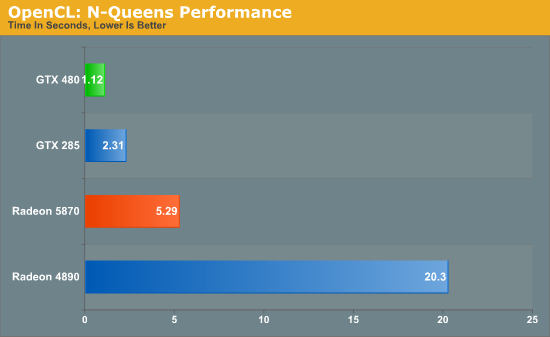
This benchmark offers a distinct advantage to NVIDIA GPUs, with the GTX cards not only beating their AMD counterparts, but the GTX 285 also beating the Radeon 5870. Due to the significant underlying differences of AMD and NVIDIA’s shaders, even with a common API like OpenCL the nature of the algorithm still plays a big part in the performance of the resulting code, so that may be what we’re seeing here. In any case, the GTX 480 is the fastest of the GPUs by far, beating out the GTX 285 by over half the time, and coming in nearly 5 times faster than the Radeon 5870.
Our second OpenCL benchmark is a post-processing benchmark from the GPU Caps Viewer utility. Here a torus is drawn using OpenGL, and then an OpenCL shader is used to apply post-processing to the image. Here we measure the framerate of the process.
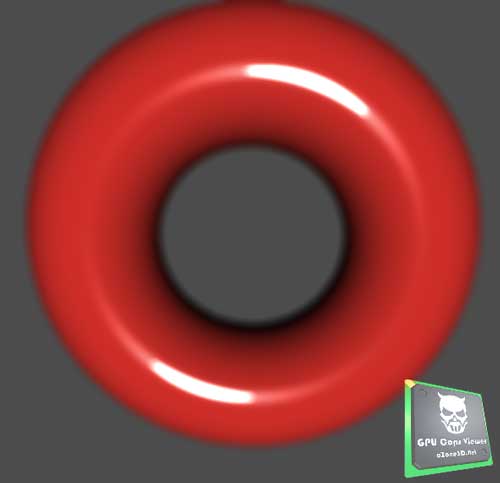
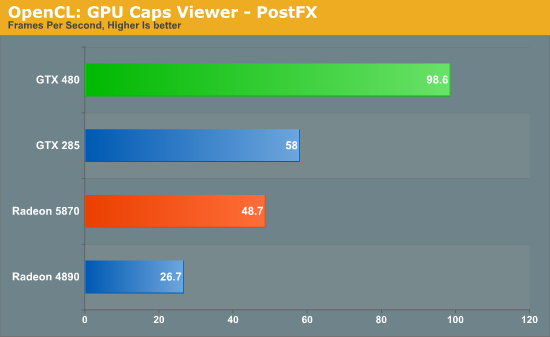
Once again the NVIDIA cards do exceptionally well here. The GTX 480 is the clear winner, while even the GTX 285 beats out both Radeon cards. This could once again be the nature of the algorithm, or it could be that the GeForce cards really are that much better at OpenCL processing. These results are going to be worth keeping in mind as real OpenCL applications eventually start arriving.
Moving on from cross-GPU benchmarks, we turn our attention to CUDA benchmarks. Better established than OpenCL, CUDA has several real GPGPU applications, with the limit being that we can’t bring the Radeons in to the fold here. So we can see how much faster the GTX 480 is over the GTX 285, but not how this compares to AMD’s cards.
We’ll start with Badaboom, Elemental Technologies’ GPU-accelerated video encoder for CUDA. Here we are encoding a 2 minute 1080i clip and measuring the framerate of the encoding process.
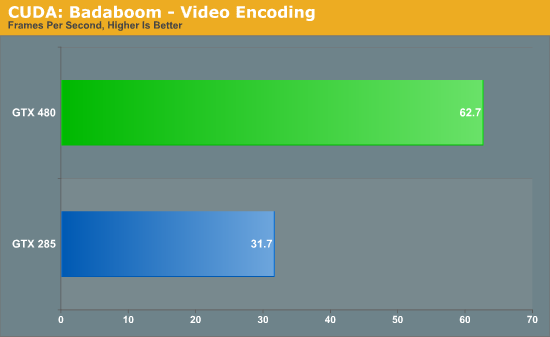
The performance difference with Badaboom is rather straightforward. We have twice the shaders running at similar clockspeeds, and as a result we get twice the performance. The GTX 480 encodes our test clip in a little over half the time it took the GTX 280.
Up next is a special benchmark version of Folding@Home that has added Fermi compatibility. Folding@Home is a Standford research project that simulates protein folding in order to better understand how misfolded proteins lead to diseases. It has been a poster child of GPGPU use, having been made available on GPUs as early as 2006 as a Close-To-Metal application for AMD’s X1K series of GPUs. Here we’re measuring the time it takes to fully process a sample work unit so that we can project how many nodes (units of work) a GPU could complete per day when running Folding@Home.

Folding@Home is the first benchmark we’ve seen that really showcases the compute potential for Fermi. Unlike everything else which has the GTX 480 running twice as fast as the GTX 285, the GTX 480 is a fewtimes faster than the GTX 285 when it comes to folding. Here a GTX 480 would get roughly 3.5x as much work done per day as a GTX 285. And while this is admittedly more of a business/science application than it is a home user application (even if it’s home users running it), it gives us a glance at what Fermi is capable when it comes to compuete.
Last, but not least for our look at compute, we have another tech demo from NVIDIA. This one is called Design Garage, and it’s a ray tracing tech demo that we first saw at CES. Ray tracing has come in to popularity as of late thanks in large part to Intel, who has been pushing the concept both as part of their CPU showcases and as part of their Larrabee project.

In turn, Design Garage is a GPU-powered ray tracing demo, which uses ray tracing to draw and illuminate a variety of cars. If you’ve never seen ray tracing before it looks quite good, but it’s also quite resource intensive. Even with a GTX 480, with the high quality rendering mode we only get a couple of frames per second.
On a competitive note, it’s interesting to see NVIDIA try to go after ray tracing since that has been Intel’s thing. Certainly they don’t want to let Intel run around unchecked in case ray tracing and Larrabee do take off, but at the same time it’s rasterization and not ray tracing that is Intel’s weak spot. At this point in time it wouldn’t necessarily be a good thing for NVIDIA if ray tracing suddenly took off.
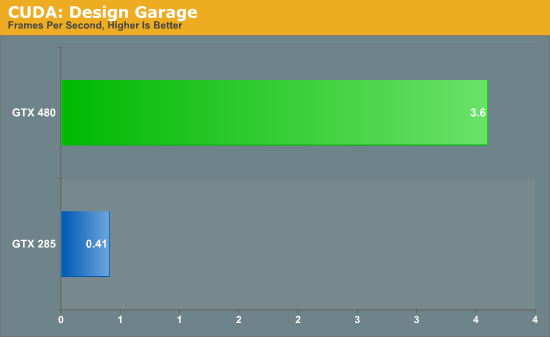
Much like the Folding@Home demo, this is one of the best compute demos for Fermi. Compared to our GTX 285, the GTX 480 is eight times faster at the task. A lot of this comes down to Fermi’s redesigned cache, as ray tracing as a high rate of cache hits which help to avoid hitting up the GPU’s main memory any more than necessary. Programs that benefit from Fermi’s optimizations to cache, concurrency, and fast task switching apparently stand to gain the most in the move from GT200 to Fermi.










196 Comments
View All Comments
Headfoot - Monday, March 29, 2010 - link
Unless you are an insider all of this "profitability" speculuation is just that, useless speculation.The reason they make both companies chips is more likely due to diversification, if one company does poorly one round then they are not going to go down with them. I'd hate to make ATI chips during the 2900XT era and i'd hate to make nVidia chips during the 5800 FX era
blindbox - Saturday, March 27, 2010 - link
I know this is going to take quite a bit of work, but can't you colour up the main cards and its competition in this review? By main cards, I mean GTX 470, 480 and 5850 and 5870. It's giving me a hard time to make comparison. I'm sure you guys did this before.. I think.It's funny how you guys only coloured the 480.
blindbox - Saturday, March 27, 2010 - link
I know this is going to take quite a bit of work, but can't you colour up the main cards and its competition in this review? By main cards, I mean GTX 470, 480 and 5850 and 5870. It's giving me a hard time to make comparison. I'm sure you guys did this before.. I think.It's funny how you guys only coloured the 480.
iwodo - Saturday, March 27, 2010 - link
If i remember correctly Nvidia makes nearly 30- 40% of their Profits from Telsa and Quadro. However Telsa and Quadro only occupies 10% of their Total GPU volume shipment. Or 20% if we only count desktop GPU.Which means Nvidia is selling those Perfect grade Fermi 512 Shader to the most profitable market. And they are just binning these chips to lower grade GTX 480 and GTX 470. While Fermi did not provide the explosion of HPC sales as we initially expected due to heat and power issues, but judging by pre-order numbers Nvidia still has quite a lot of orders to fulfill.
The Best thing is we get another Die Shrink in late 2010 / early 2011 to 28nm. ( It is actually ready for volume production in 3Q 2010 ). This should bring Lower Power and Heat. Hopefully the next update will get us a much better Memory Controller, with 256Bit controller and may be 6Ghz+ GDDR5 should offer enough bandwidth while getting better yield then 384Bit Controller.
Fermi may not be exciting now, but it will be in the future.
swing848 - Saturday, March 27, 2010 - link
We are not living in the future yet.When the future does arrive I expect there will also be newer, better hardware.
Sunburn74 - Saturday, March 27, 2010 - link
So how do you guys test temps? It's not specifically stated. Are you using a case? An open bench? Using readings from a temp meter? Or system readings from catalyst or nvidia control panel? Please enlighten. It's important because people will eventually have to extrapolate your results to their personal scenarios which involve cases of various designs. 94 degrees measured inside a case is completely different from 94 degrees measured on an open bench.Also, why are people saying all this stuff about switching sides and families? Just buy the best card available in your opinion. I mean it's not like ATI and Nvidia are feeding you guys and clothing your kids and paying your bills. They make gpus, something you plug into a case and forget about if it's working properly. I just don't get it :(
Ryan Smith - Saturday, March 27, 2010 - link
We're using a fully assembled and closed Thermaltake Spedo with a 120mm fan directing behind the video cards feeding them air. Temperatures are usually measured with GPU-Z unless for some reason it can't grab the temps from the driver.hybrid2d4x4 - Saturday, March 27, 2010 - link
Thanks for elaborating on the temps as I was wondering about that myself. One other thing I'd like to know is how the VRM and RAM temps are on these cards. I'm assuming that the reported values are for just the core.The reason I ask is that on my 4870 with aftermarket cooling and the fan set pretty low, my core always stayed well below 65, while the RAM went all the way up to 115 and VRMs up to ~100 (I have obviously increased fan speeds as the RAM temps were way too hot for my liking- they now peak at ~90)
Ryan Smith - Saturday, March 27, 2010 - link
Correct, it's just the core. We don't have VRM temp data for Fermi. I would have to see if the Everest guys know how to read it, once they add support.shiggz - Friday, March 26, 2010 - link
I just am not interested in a card with a TDP over 175W. When I upgraded from 8800gt to GTX 260 It was big jump in heat and noise and definitely at my tolerance limit during the summer months. I found myself under-clocking a card I had just bought.175W max though a 150W is preferred @ 250$ and I am ready to buy if NVIDIA wont make it then I will switch back to ATI.